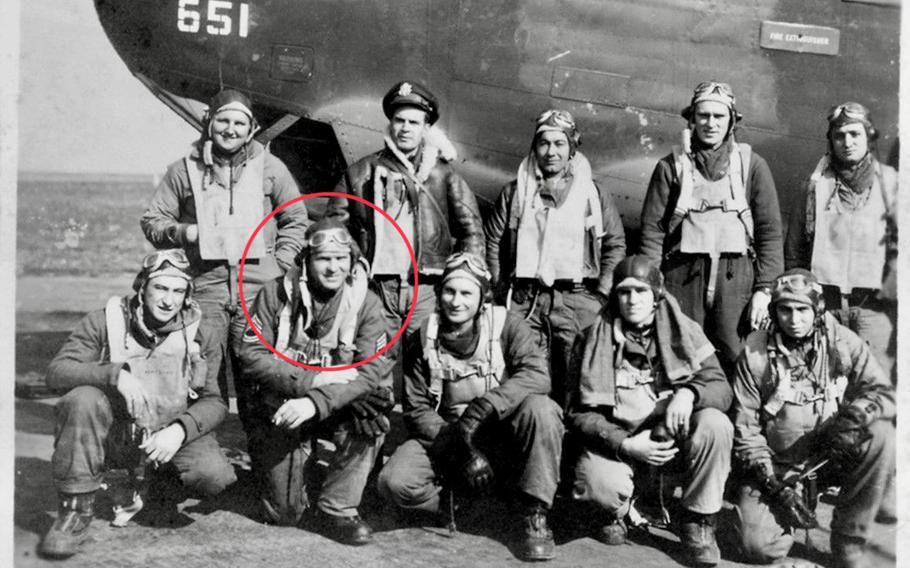
U.S. Army Air Forces Tech. Sgt. Sanford G. Roy, circled in red, is seen in this undated photo. Roy volunteered for the U.S. Army and was assigned to the Army Air Forces in August 1942. He was killed in action while on a bombing mission to Brunswick, Germany on April 8, 1944. (Defense POW/MIA Accounting Agency)
CHATTANOOGA, Tenn. (Tribune News Service) — A Chattanooga, Tenn. World War II airman who was a gunner on the American bomber “Little Joe” when it went down in flames on a German farm will be laid to rest at the Chattanooga National Cemetery 81 years to the day after he was killed in action.
Tech. Sgt. Sanford Gordon Roy had just turned 31 and was aboard Little Joe when it was shot down over Germany on April 8, 1944, according to a news release from the Defense POW/MIA Accounting Agency and his obituary. Roy volunteered for the U.S. Army and was assigned to the Army Air Forces in August 1942.
That April day in 1944, Roy and nine fellow crew members were on a bombing mission — part of a formation of 200 Allied bombers en route to a target in Brunswick, Germany — to destroy airfields and manufacturing plants, along with German aircraft on the ground, according to the agency and obituary information provided by the family. Roy was a “left waist” gunner on the B-24 Liberator, meaning he was positioned to fire a .50 caliber machine gun from an opening in the side of the plane.
But as the crew members flew, 50 to 60 German fighters with a mix of Focke-Wulf 190s and Messerschmitt 109s attacked the formation. The left and right waist gunners defended the B-24’s sides while their fellow gunners defended the nose, top, bottom and tail of the aircraft.
“Other bombers in the group saw Little Joe take heavy fire from the German fighter planes and roll onto its back, catching fire and falling out of the formation,” the obituary states. “No one saw any parachutes leave the plane as it headed towards the earth.”
Little Joe was part of the Mighty Eighth Air Force operated out of England from December 1943 to May 1945, a period during which it lost 58 aircraft and 366 air crew members, the obituary said. Little Joe was among 31 bombers shot out of the sky on April 8, 1944.
On April 8, a total of 31 bombers were shot out of the sky with Little Joe, Roy and his fellow airmen plunging to the earth somewhere over Salzwedel, Germany, according to the obituary. At the end of the war, some effort was made to locate the plane by talking with people who lived in the area and by using German records, but no information was in their records.
The location where the plane went down was in Russian-occupied Germany. Eyewitnesses to the incident said two planes were shot down. Nine crew members aboard the first plane that crashed were buried by townspeople, but Little Joe was burning and exploded as it attempted to land, the obituary said.
The mystery of Little Joe remained in 1951 when the military listed the plane as “unrecoverable,” but in 2015, the independent group, Missing Allied Air Crew Research Team, contacted the accounting agency about a possible crash site being located.
But there was still another obstacle.
“The place where the plane was thought to have crashed was farmland, and the owner did not want his field dug up, Roy’s obituary states.
The land involved had to be leased from the farmer before an excavation could begin, but then the remains of the plane and all 10 crew members were found, the obituary said. In August 2021, military officials began archaeological testing and found artifacts believed to have belonged to Little Joe’s tail gunner.
By November 2023, the entire area had been excavated and all artifacts sent to accounting agency labs for DNA testing, and in July 2024, the family was told Sanford’s remains had been positively identified.
Roy was born on March 21, 1913, in Chattanooga, son of George and Dora Roy, his obituary said. Roy graduated from Chattanooga Central High School in 1934 and worked at the Gilman Paint plant in Chattanooga, where he ended up getting a job helping to paint the Rock City signs on barns around the South. The technical sergeant was awarded the Purple Heart, Air Medal, Army Good Conduct Medal, American Campaign Medal, European-African-Middle Eastern Medal, Bronze Service Star, World War II Medal, U.S. Army Air Force Aerial Gunner Badge Wings and Honorable Service Lapel Button.
Roy’s name is recorded on the Walls of the Missing at Netherlands American Cemetery, Margraten, Netherlands, along with others still missing from World War II. A rosette will be placed next to his name to indicate he has been accounted for.
A graveside service will be held at the Chattanooga National Cemetery at 12:30 p.m. April 8, with full military honors. The public is invited.
© 2025 the Chattanooga Times/Free Press (Chattanooga, Tenn.).
Visit www.timesfreepress.com.
Distributed by Tribune Content Agency, LLC.